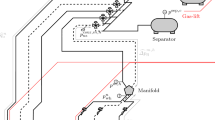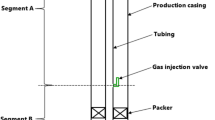Abstract
Continuous gas lift is a popular method to enhance productivity in offshore oil platforms. We propose a steady-state two-stage stochastic programming model to maximize production, where the first-stage injection level determines the production potential, while recourse actions ensure capacity and platform constraints for each uncertainty realization. In particular, we develop a concave approximation of the performance curve that incorporates uncertainty in the water cut (WC) and gas–oil ratio (GOR). We generate WC and GOR realizations using a two-step data-driven approach: we extrapolate the trends using a \(\ell _1\)-filter, and bootstrap historical deviations to generate future realizations of WC and GOR. We present numerical results for the sample average approximation of the problem and assess the solution quality using standard techniques in the literature. Our numerical results suggest that taking uncertainty into account in the problem can lead to considerable gains.
Similar content being viewed by others
Notes
SOS2 stands for Special Ordered Sets of type 2, which is an ordered set of non-negative variables with the following properties: at most two can be non-zero, and if two are non-zero these must be consecutive in their ordering.
Here, \(\xi\) is viewed as a particular realization of the random variable \(\xi\); we use the same symbol in order to alleviate the notation, the interpretation will be clear from the context.
References
Alarcón G, Torres C, Gómez L (2002) Global optimization of gas allocation to a group of wells in artificial lift using nonlinear constrained programming. J Energy Res Technol 124(4):262–268
Birge J, Louveaux F (2011) Introduction to stochastic programming. Springer, Berlin
Camponogara E, Teixeira A, Hulse E, Silva T, Sunjerga S, Miyatake L (2017) Integrated methodology for production optimization from multiple offshore reservoirs in the santos. IEEE Trans Autom Sci Eng 14(2):669–680
Dunning I, Huchette J, Lubin M (2017) Jump: a modeling language for mathematical optimization. SIAM Rev 59(2):295–320
Fang W, Lo K et al (1996) A generalized well management scheme for reservoir simulation. SPE Reserv Eng 11(02):116–120
Foss B, Jensen J (1981) Performance analysis for closed-loop reservoir management. SPE J 16(1):183–190
Foss B, Knudsen B, Grimstad B (2018) Petroleum production optimization—a static or dynamic problem? Comput Chem Eng 20:245–253
Gunnerud V, Conn A, Foss B (2013) Embedding structural information in simulation-based optimization. Comput Chem Eng 53:35–43
Hanssen K, Foss B (2015) Production optimization under uncertainty applied to petroleum production. IFAC-PaersOnline 48(8):217–222
Homem-de-Mello T, Bayraksan G (2014) Monte Carlo sampling-based methods for stochastic optimization. Surv Oper Res Manag Sci 19:56–85
Kanu E, Mach J, Brown K et al (1981) Economic approach to oil production and gas allocation in continuous gas lift (includes associated papers 10858 and 10865). J Petrol Technol 33(10):1–887
Keha A, de Farias Jr I, Nemhauser G (2004) Models for representing piecewise linear cost functions. Oper Res Lett 32(1):44–48
Kim SJ, Koh K, Boyd S, Gorinevsky D (2009) \(\ell _1\) trend filtering. SIAM Rev 51(2):339–360
Kleywegt A, Shapiro A, Homem-de-Mello T (2001) The sample average approximation method for stochastic discrete optimization. SIAM J Optim 12(2):479–502
Mak WK, Morton D, Wood K (1999) Monte carlo bounding techniques for determining solution quality in stochastic programs. Oper Res Lett 24(1–2):47–56
Misener R, Gounaris C, Floudas C (2008) Global optimization of gas lifting operations: a comparative study of piecewise linear formulations. Ind Eng Chem Res 48(13):6098–6104
Ruszczyński A (2003) Decomposition methods. In: Ruszczyński A, Shapiro A (eds) Handbook of stochastic optimization. Elsevier Science Publishers B.V, Amsterdam
Shapiro A, Dentcheva D, Ruszczyński A (2014) Lectures on stochastic programming : modeling and theory, 2nd edn. SIAM, Philadelphia
Teixeira AF (2013) Otimização da produção de poços de petróleo com gas lift contínuo. Master’s thesis
Valladão D, Torrado R, Flach B, Embid S (2013) On the stochastic response surface methodology for the determination of the development plan of an oil and gas field, pp 534–545. https://www.scopus.com/inward/record.uri?eid=2-s2.0-84899412890&partnerID=40&md5=4d0c1b8b5ad4de206bcafe60d461f8ff
Acknowledgements
The authors acknowledge the support of Cenpes and Embrapii.
Author information
Authors and Affiliations
Corresponding author
Additional information
Publisher's Note
Springer Nature remains neutral with regard to jurisdictional claims in published maps and institutional affiliations.
Rights and permissions
About this article
Cite this article
Gamboa, C., Silva, T., Valladão, D. et al. A stochastic optimization model for short-term production of offshore oil platforms with satellite wells using gas lift. TOP 28, 549–574 (2020). https://doi.org/10.1007/s11750-020-00547-0
Received:
Accepted:
Published:
Issue Date:
DOI: https://doi.org/10.1007/s11750-020-00547-0
Keywords
- Oil production optimization
- Continuous gas lift
- Two-stage stochastic programming
- Sample average approximation












